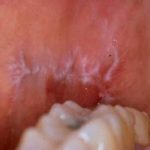
Lichen planus is an inflammatory condition that may affect the skin, hair, nails and mucous membranes. oral lichen planus affects between 0.5 – 2% of the population with a predilection for middle and female. Manifestations of oral lichen planus (OLP) range from the most common reticular type to erosive, atrophic, and plaque type, presenting diagnostic challenges with other white lesions. . A case of oral squamous cell carcinoma (OSCC), was reported in a n OLP patients in 1910 and a number of studies have subsequently looked at malignant transformation in OLP patients.
The aim of this review was to assess the malignant transformation rate (TR) of oral lichen planus (OLP) and its risk factors and whether or not oral lichenoid lesions (OLL) have a different malignant TR.
Methods
Searches were conducted in the PubMed, Scopus, and Web of Science databases. English language observational studies with more than 50 patients with biopsy driven diagnosis were considered.
Two reviewers independently selected studies with data being abstracted independently by 3 reviewers. Study were assessed for quality using a modified Newcastle- Ottawa scale. A random-effects meta-analysis of the pooled proportion (PP) of the rate of malignant transformation for OLP lesions was conducted.
Results
- 21 studies (3 prospective, 18 retrospective) involving a total of 6559 patients were included
- Follow up periods ranged from 18-300 months.
- 92 oral squamous cell carcinomas developed.
- Mean age at the diagnosis was 62.9 (63.7 females and 62.3 males
- Mean time for transformation was 61.9 months.
| No of patients followed | Malignant transformation rate | |
| Overall | 6559 | 1.4% |
| Oral lichen planus | 6353 | 1.37% |
| Oral lichenoid lesions | 206 | 2.43% |
Conclusions
The authors concluded: –
This systematic review confirms that both OLP and OLL, the latter with a slightly higher TR, may be considered potentially malignant disorders and suggest that erosive type, female gender and tongue site should be considered as risk factors for OLP transformation. Major efforts should be done to establish strict clinical and histological criteria to diagnose OLP and to perform sounder methodological observational studies.
Comments
3 major databases were search for this review although limiting inclusion to English language papers is likely to have excluded some relevant studies. A majority (86%) of the included studies are retrospective which raises concerns regarding the potential for selection and recall bias as well as missing data. As the authors note only a small number of studies report extensively on other risk factors for oral cancer. Only 4 of the included studies scored 6 or more on the Newcastle-Ottawa Scale.
This review suggests an overall TR of 1.4% with a TR of 1.37% for OLP patients and a higher rate of 2.43% for OLL patients although there is a very small sample for the OLL patients and it would have been helpful if 95% confidence intervals had been presented. A 2014 review by Fitzpatrick et al included 16 studies (7806) patients finding an overall TR for OLP patients of 1.09%. While a 2017 review by Aghbari et al pooling data from 57 studies (19,676 patients) found an overall TR of 1.1% (95%CI: 0.9%, 1.4%) with a lower rate of 0.9% (95%CI: 0.5%, 1.3%) was found in more recent studies employing the World Health Organization-2003 diagnostic criteria. Aghbari et al also noted a higher TR in OLL patients of 2.5%, (95%CI; 1%, 4%) similar to this current review.
Higher quality long-term prospective studies with more detailed recording of risk factors are needed to help clarify the management of these patients.
Links
Primary Paper
Giuliani M, Troiano G, Cordaro M, Corsalini M, Gioco G, Lo Muzio L, Pignatelli P, Lajolo C. Rate of malignant transformation of oral lichen planus: A systematic review. Oral Dis. 2018 May 8. doi: 10.1111/odi.12885. [Epub ahead of print] Review. PubMed PMID: 29738106.
Original review protocol on PROSPERO
Other references
Fitzpatrick SG, Hirsch SA, Gordon SC. The malignant transformation of oral lichen planus and oral lichenoid lesions: a systematic review. J Am Dent Assoc. 2014 Jan;145(1):45-56. doi:10.14219/jada.2013.10. Review. PubMed PMID: 24379329.
Aghbari SMH, Abushouk AI, Attia A, Elmaraezy A, Menshawy A, Ahmed MS, Elsaadany BA, Ahmed EM. Malignant transformation of oral lichen planus and orallichenoid lesions: A meta-analysis of 20095 patient data. Oral Oncol. 2017May;68:92-102. doi: 10.1016/j.oraloncology.2017.03.012. Epub 2017 Apr 5. Review. PubMed PMID: 28438300.
Dental Elf -Oral Lichen Planus Blogs
Picture Credits
By James, Candice, Mai – http://bohone09.wikispaces.com/Group+1, CC BY-SA 3.0,
